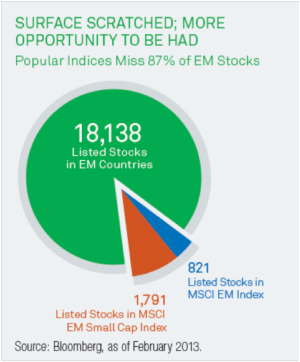Emerging markets, it seems, have garnered a lot of attention of late. To classify that attention would be difficult — some has been good, some bad; some of it accurate, some not so much. As the largest manager of EM assets in the world, we are acutely attuned to the 20+ nations that bear the EM moniker. Our quick assessment is that EMs present tremendous opportunity, but the entire EM landscape cannot be painted with one brush. Differentiation is key, and a multi-asset approach may well unlock the most potential.
What’s to Like
There is a lot to like about emerging markets. Some are more “likeable” than others, but overall, it’s fair to say these are some of the world’s fastest-growing, most dynamic economies. Urbanization is just beginning in many regions, China and India included, and many businesses are poised to benefit from the wave of development and increasing consumerism. Generally young populations that are working, earning and spending also bode well for many EM stock markets.
At the same time, credit conditions in many EMs are pristine. Debt levels and fiscal balances appear healthier in EMs than in developed markets. In fact, EM countries are net creditors to DMs. The risk of default also appears tame, with default rates in EM investment-grade sovereign debt at 0%. All told, EM fixed income offers attractive opportunity, particularly for US investors who are hard-pressed to source ample yield in US government debt.
 What’s Changed
What’s Changed
Over the past 25 years, the EM category as a whole experienced tremendous growth, and investors were generally able to ride the macro wave. There were few choices to be made. Today, the emerging world opportunity is not neatly summarized and represented by the broad EM indices. In fact, many of these indices fail to capture the full breadth of the opportunity, with the hallmark MSCI EM Index offering exposure to just 800 of the more than 18,000 listed EM stocks.
The EM opportunity over the next 25 years is likely to be much more nuanced as some countries leap from “emerging” to “emerged,” while the social, economic and political agendas of others continue to evolve at a slower pace. There will be winners and losers, and it will be important to understand not only the workings of individual countries, but of individual sectors, industries and businesses as well.
What to Worry About
Investing comes with worries than can range from the unpredictable “keep you up at night” systemic threats, to the secular challenges underlying the investment story. In EMs, we would cite a few of the latter.
First, consider that gross domestic product (GDP) growth does not automatically translate to investment opportunity, a reality that can trip up many an investor. The world’s largest emerging market, China, highlights the shortfalls of using GDP as a predictor of investment returns. While the country’s GDP increased more than sevenfold over the past two decades, the Chinese stock market (as measured by the MSCI China Index) lost roughly 30%.
Second, diversification can be difficult today. Investors have long used EMs to diversify portfolios largely tied to the fortunes of the developed world. This strategy worked well for many years: From 1991 to 2000, the MSCI EM Index had a correlation of just over 0.30 to the S&P 500 Index during up markets, and 0.60 during down markets. But correlations have increased meaningfully over the past decade, particularly during down markets — precisely the time when investors could most benefit from diversification.
Then there’s the ever-present volatility, particularly brutal on the down side, and the startling rate of change in some EM countries that can be impossible for investors to process and plan for — much less invest around.
What to Watch
World stocks have had a strong first half, but EMs have not fully enjoyed the rally. This actually makes valuations quite compelling on a relative basis, particularly considering the solid fundamentals that underscore many EM companies. We recommend investors keep an eye out for buying opportunities.
China is clearly one to watch, having been a key driver of not just EM growth, but world growth, for the past several years. China doubled its GDP per capita in just 12 years. For comparison purposes, the UK required 154 years to accomplish the same feat, with a significantly smaller population. China’s growth will likely slow from its blockbuster pace. We’re not overly concerned — in fact, we remain long on China — but we’re watchful.
What to Do
So what do I do with my money? It’s the question we ponder every day, and we would offer a few considerations for advisors and investors:
Rethink and Refine- Consider what it means to be an investor in emerging markets today, and change your approach accordingly. Re-examine equity holdings at the broad index level and the individual security level. Rather than relying exclusively on a capitalization-weighted benchmark, consider minimum-volatility indices, which are designed to deliver lower volatility than their cap-weighted peers, while still participating in the majority of their upside performance.
Think Outside the Box- EM investing is not limited to direct investment in companies domiciled in the 20+ emerging countries. In an era defined by increasing globalization and EM urbanization, many companies located in the developed world derive a significant portion of their revenue from the emerging world. EM opportunities may be found where you least expect.
Don’t Forget Debt- As noted earlier, fundamentals are attractive, and investors may find that an allocation to EM debt helps to capture some of the exposure to GDP that is missing from their equity approach. As GDP improves in these countries, it begets a virtuous circle of increased tax receipts, stronger government balance sheets, and a corresponding increase in the price of sovereign debt, thereby benefiting bondholders.
Consider a Multi-Asset Solution- A professionally managed multi-asset approach considers the full opportunity set in emerging markets and combines equity, debt, currencies and real assets into one vehicle. It uses active and passive management to optimize equity allocations, invests in local currency bonds to capture GDP exposure, and actively manages currency risk. Long/short strategies are also employed in an effort to manage the not insignificant EM volatility.A holistic EM portfolio can help cut through the confusion while seeking to capitalize on all this attractive category has to offer.
Jeff Shen, PhD, is a Managing Director and Head of Emerging Markets at BlackRock. He oversees the largest EM investment team in the asset management industry.
DISCLOSURE
This material is not intended to be relied upon as a forecast, research or investment advice, and is not a recommendation, offer or solicitation to buy or sell any securities or to adopt any investment strategy. The opinions expressed are as of June 2013, and may change as subsequent conditions vary. The information and opinions contained in this material are derived from proprietary and nonproprietary sources deemed by BlackRock to be reliable, are not necessarily all-inclusive and are not guaranteed as to accuracy. Past performance is no guarantee of future results. There is no guarantee that any forecasts made will come to pass. Reliance upon information in this material is at the sole discretion of the reader.
Stock andbond values fluctuate in price so the value of your investment can go down depending on market conditions. International investing involves additional risks, including risks related to foreign currency, limited liquidity, less government regulation, and the possibility of substantial volatility due to adverse political, economic or other developments. These risks may be magnified for investment in emerging or smaller capital markets. The two main risks related to fixed income investing are interest rate risk and credit risk. Typically, when interest rates rise, there is a corresponding decline in the market value of bonds. Credit risk refers to the possibility that the issuer of the bond will not be able to make principal and interest payments.
BLACKROCK is a registered trademark of BlackRock, Inc. All other trademarks are the property of their respective owners.
FOR MORE INFORMATION: www.blackrock.com
NOT FDIC INSURED / MAY LOSE VALUE / NO BANK GUARANTEE
© 2013 BlackRock, Inc. All Rights Reserved.
USR-2308

